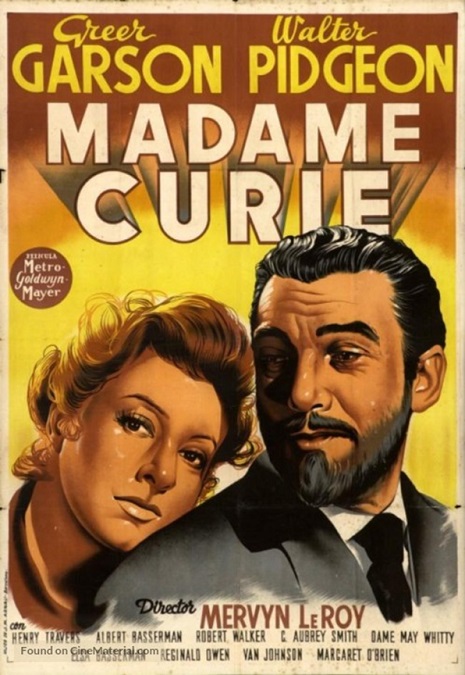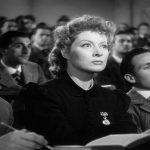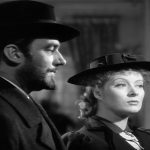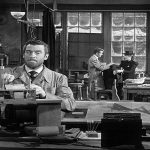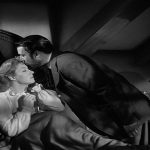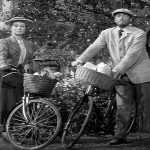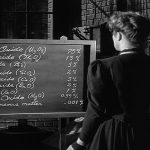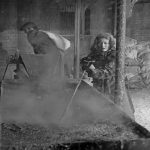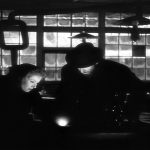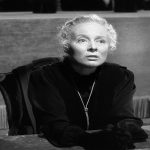Madam Curie – 1943
This came dangerously close to being a silly movie. I was expecting, or at least hoping for, a biopic about Marie Curie, a female scientist in a male dominated world who surpassed all her peers and discovered the elusive element radium. Instead, what I got was a sappy romantic drama with poorly written dialogue. I mean, really. Some of the dialogue was distractingly bad. Unfortunately, the Hollywood machine of the 1940s turned what could have been an interesting story into a typical, predictable, cookie-cutter film.
The movie spent most of its 2 hour length focusing on the fictionalized romance between the Polish born Marie Sklodowska, played by Greer Garson, and the Frenchman, Pierre Curie, played by, of course, Walter Pidgeon. She was the brilliant and stunningly beautiful student who didn’t have enough money to buy food. He was the dashing and handsome professor who thought that all women were vapid and distracting. And they weren’t the only characters who were portrayed as walking stereotypes.
Pierre’s lab assistant, David, played by Robert Walker, was ridiculous. Pierre, regretting that he had made the mistake of allowing a woman to work in his lab, says that women are either empty-headed nuisances or distractions. David replies that female scientists are ugly as well. But when the beautiful Marie arrives, David turns into a cartoon character, falling all over himself to make her notice him. And apparently, when a man whistles, it means he is stupidly falling in love with a woman.
The ridiculous proposal scene really demonstrated the awful dialogue. Pierre was positively silly as he asked Marie to marry him, saying things like, “You have a wonderful scientific mind. I likewise have a scientific mind. Our subsequent marriage would be one based on our mutual search for knowledge. Love will be a secondary concern. Would you consent to this arrangement?” Unfortunately, I did not write down the actual dialogue, but I don’t think I’m that far off. I’m sorry, but in reality, that kind of a man would be called a moron.
And that is just one example of how bad the dialogue was. Here’s another approximation. Marie and Pierre have drawn a black curtain around their experiment because it apparently requires lower light levels. The camera stays focused on the evaporating bowl but we hear Pierre speaking to his wife from behind the curtain. “Now all we have to do is wait, Marie. Here, why don’t you sit down in this chair? I’ll place this shawl around your shoulders to help keep you warm.” After that, I expected to hear him say something like, “Now, I’m going to put my own chair next to yours so that we’ll be sitting close to each other.”
If only the film had cut out the forced sentimentality of the romance and stayed closer to the true story of Madame Curie, it would have been a much more interesting film. The movie completely omitted several crucial facts about the extraordinary woman. For example, Madame Curie actually discovered 2 elements, not just radium in 1898. She also discovered polonium in the same year. Also, her Nobel Prize in Physics, won in 1903, was shared with her husband. But she earned her own Nobel Prize in Chemistry in 1911, 5 years after Pierre’s death in 1906.
Now, I don’t want it to sound like I hated the film. On the contrary, it was entertaining enough, if, as I said before, a bit predictable. Garson had some really strong moments in the film. The film ended much like several of her other films like Blossoms in the Dust, where the last few minutes of the film are a heartfelt and inspirational speech about the importance of her character’s work and the importance of striving to become more than what you are.
I also liked Henry Travers, who most people know as Clarence Odbody, the Guardian Angel from the 1946 Classic, It’s A Wonderful Life, and Dame May Whitty who played Pierre’s parents. They were both portrayed as a kindly couple, even if Eugene could get a bit cantankerous at times. Marie and Pierre’s two daughters were almost throw-away characters. The film barely mentioned them in passing until the last half hour of the film when they could be brought in for a little contrast to Marie’s depression over believing her experiment had failed.
All in all, the movie was mildly entertaining, but I believe it had the potential to be much more. They just focused too much on the romance and not enough on the actual career of Marie Curie. If you go into it expecting a biography, you will be disappointed. It was really a romance, plain and simple. But that being said, I have to agree that Garson and Pidgeon had a really good on-screen… chemistry.
